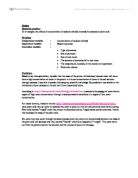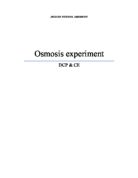Method:
- Peel a healthy large potato.
- Using a cork borer, cut 15 pieces of 2 cm long potato chips. Make sure all chips are equal in size and solidity (wholeness), by observing each chip.
- Place exactly 30 mL of water in a dry cup using a measuring cylinder.
- Repeat the previous process using different concentrations of sugar solutions to replace the water, repeat 4 times using the concentrations 0.1, 0.3, 0.6 and 0.8 mols-1.
- Write the type of solute each cup contains on the cups with a vivid
- Place a blue coloured pin in 5 potato chips, push the pins to the middle of the chips.
- Repeat the previous process with 5 more chips using red pins. Then repeat again with 5 more potato chips using white pins.
- Group a blue, and a red, and a white pinned potato chip into a set. Repeat for all remaining potato chips.
- Measure the mass of each individual chip with the pins using an electronic scale and plot the initial mass of each chip on a table similar to the one below, keeping the chips still in their coloured sets.
- Place each set in a cup of solute and record the type of solute used, next to the initial mass on the table.
- Leave in the cup without any interference for 15 minutes, record the time using a stop watch starting from the time the chips are placed in the solutions.
- After 15 minutes remove all chips onto five separate pieces of paper towels, each with the type of solute written on the towels (to avoid confusion), and make sure to keep the chips in their original sets.
- Wait 1 minutes.
- Measure the mass of each chip after 15 minutes of osmosis. Record the data onto another identical table, however instead of “initial mass” change it to “mass after osmosis”. Keep the data in the same order as to the original table.
Data recorded during the experiment:
Initial Mass of potato chips (with pins)
Mass of potato chips after osmosis
Percentage Mass Change
Average Percentage Mass Change
Average Percentage Mass Change Graph
Conclusion: To begin we need to understand the meaning of Osmosis. Osmosis is the diffusion of molecules through a semi-permeable membrane from a place of higher concentration to a place of lower concentration until the concentration on both sides is equal.
The results above confirm the meaning of Osmosis and it makes the hypothesis correct. As the results show, in the water solution the potato chip actually gains mass after 15 minutes. This is because the water concentration inside the potato is lower than the water concentration in the water solution, hence the water in the solution will diffuse into the potato through its semi-permeable membrane from a place of higher concentration to a place to lower concentration, to balance out the water concentration in both the potato and the water solution.
As the sugar concentration increases, it is clear that less water concentration is present in the solution, hence the potato starts to gain less mass. Starting from the sugar concentration of 0.3 mol-1, the potato actually decreases in mass after 15 minutes. The potato decreases in mass because the sugar concentration of 0.3 mol-1 actually has less water concentration than inside the potato, hence osmosis will occur, and water from inside the potato will diffuse into the sugar solution to balance out the concentration of water. This is even more evident as the sugar concentration increases to 0.6 mol-1 and 0.8 mol-1. In the sugar concentration of 0.6 mol-1, there is a -4.461% decrease in mass after osmosis, because that percentage of the water in the potato chip has diffused into the sugar solution due to the imbalance of water concentration in the sugar solution and the potato chip.
This experiment has clearly proved the meaning of Osmosis by clearly showing the diffusion of water from the water solution into the potato chip when the chip was placed in the water solution, and this caused an increase in mass after 15 minutes. In high concentrations of sugar solutions, it was evident that diffusion has occurred in the opposite direction due to the low concentration of water in the sugar solutions, this caused water from inside the potato chip to diffuse into the sugar solutions, and evidently a decrease in mass of the potato chip can be observed.
Evaluation:
There were some inaccuracies in this experiment.
When the potatoes were being dried after removal from the solutes, the time period allowed for drying was not timed. There is a possibility that the potatoes were not dried enough, and much of the solution was still present on the surface of the potato chips, affecting its mass.
The sheet used to record the data was placed too close to the solutions, hence water was splashed on the sheet. This caused uncertainties for reading the data when it was being processed.
Cutting the pieces of potato chips into equal sizes was a step that caused inaccuracies. It was difficult to obtain pieces of potato with the same solidity (wholeness) simultaneously making sure they were the same size, mainly because a whole potato was not used, due to the size of the class, a used potato was the only the only option available. This may have caused a difference in surface area for each potato chip, and causing osmosis to occur faster in one chip than the other.
There were inaccuracies in removing the potato chips from the solutes. The removal was simply done by human draining, which could have left more solutes in certain chips and less in others. This may have caused inaccuracies in the measurements of the mass of the potato chip.
Modifications:
There are definite improvements that could benefit the validity and accuracy of the experiment.
When the potatoes are being dried, a timer should be used to time for one minute, which is the time allowed for the drying process. This provides an adequate time period for the potato chips to dry. By timing the process, it makes the experiment fair and reinsures that the potatoes all received the same amount of time to dry.
A whole potato should be used in future experiments. This ensures that all the potato chips obtained, are wholesome and solid, instead of the soft crumbly bits of potato used in this experiment. The chips should also be cut with a sharp knife and a ruler, to ensure they are all the same size. Both of this steps will ensure the potato chips are equal in surface area, other wise osmosis could occur father in one chip than the other.
The removal of the potato chips should be done with a sterile tong, to ensure each potato chip receives the same treatment of removal. Without this process, the mass of the potato chips after removal from the solutions, may be inaccurate.
If time allows, the recording of all the data should be repeated on two separate sheets of paper, to increase accuracy, and to act as a back up to the other. Without a back up, the data could be easily destroyed, and the experiment may become completely inaccurate.
Websites Used: http://www.courseworkhelp.co.uk/GCSE/Science/17.htm









